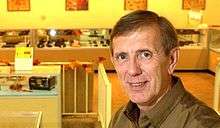Larry Paul Kelley

Larry Paul Kelley , also known as Larry P. Kelley, is an American inventor and gemologist who developed proprietary methods for manufacturing man-made gemstones. He also invented a method for making high efficient crystalline silicon material for solar cells.[1] Kelley received degrees at the University of Michigan in science, chemistry and physics.[2]
Biography

Born in 1944 and raised in Hart, Michigan, Kelly was influenced by his father, Laurence, who worked on repairing auto bodies. His father had a set of Popular Science magazines which he read through often with much interest as a boy. As a 12-year-old boy Kelley did an experiment one day based on one of these magazine articles. He understood that ruby was a chemical mixture of aluminum oxide and chromium oxide. He observed that some sandpaper that his father used had aluminum oxide dust. Kelley took some of this dust and placed onto a firebrick. He put a chip of chrome with the aluminum oxide sandpaper dust, melted them with high heat, and serendipitously created his first ruby, albeit of poor quality.[2]
As a teen, Kelley fostered his interest in science and experimentation. As a thirteen year old he shot homemade rockets over the local lake. He got into trouble with local police authorities when permission was denied to shoot these rockets so close to a heavily populated area.[3]
Kelley and his brother Arthur made some small wooden workshops in 1961 to do experiments with chemicals. In 1962 when they blew up these workshops after mixing sulfur potassium chlorate with aluminum oxide dust the boys were seriously injured but survived.[4]
Career
Kelley enrolled at the University of Michigan in the late 1960s. There he took up the study of science, chemistry, and physics. One of his studies was working as an assistant chemist at Dow Chemical. At Dow he worked with high-temperature furnaces and processing of materials using heat. At that time there was a high demand for ruby for solid-state lasers. After graduating from U of M he went into the business of making equipment to produce ruby laser rods.[2]
Kelley later learned how to cut the ruby laser rods into little chunks and then shape them into "gems" using a faceting machine. He then sold these synthetic artificial man-made gems for just under a hundred dollars each. He progressed from making rubies to manufacturing other man-made gems including an imitation diamond. Kelley turned this into a business of making man-made artificial gems for all the traditional birthstones of each of the twelve months.[2]
Shelby Gem Factory
Kelley experimented with several formulas and processes for making synthetic artificial gems. One method involved using temperature difference techniques to create crystals in a way water icicles are formed. One of these man-made gemstones made this way was a transparent clear crystal resembling glass. It looked to the naked eye like a real diamond when faceted correctly and no glass was involved in its manufacture.[2]
A second technique involves small pieces ("seeds") of mined gems put into a heated up chemical liquid. The liquid then is slowly cooled, and recrystallized to form larger pieces of the gemstone. Man-made gemstones grow from these "seeds." Kelley's technical success in growing crystals led to the founding of the Shelby Gem Factory in 1970.[2]
Semiconductor technology
In 1978 Kelley invented a unique method to create thin semiconductor films, especially useful in solar cells. Semiconductors have an absorptive graphite substrate and a layer of silicon grid-work is plated onto it. Kelley's process uses a rotating drum.[5] Surface tension is overcome by the whirling motion of the rotating drum to spread out the molten material.[6] The centrifuge invention spreads out the crystalline thin film material evenly and causes the interface to have a low amount of silicon carbide.[6] The idea is to have the thin film layers be single crystals.[6]
The title to the patent is Centrifugal forming thin films and semiconductors and semiconductor devices and is United States patent #04101925. Craig A Hardy is shown as co-inventor. Kelley's invention is cited for reference in 7 other later patents for similarity.[6]
References
- ↑ Tableman, Jan (2011), Jewel of West Michigan / Shelby Gem Factory (PDF), Okemos, Michigan: Michigan Electric Cooperative Association, p. 1,3, 10,11
- 1 2 3 4 5 6 Kates, Kristi (2012). "A Flaming Success at the Shelby Gem Factory". Northern Express newspaper. Retrieved September 3, 2015.
- ↑ "Hart Leery of Being Juvenile Cape Canaveral". Shelby Herald (page 2). Shelby, Michigan. July 7, 1957.
- ↑ "Blast Victims' Chemicals are Destroyed". Shelby Herald (front page). Shelby, Michigan. June 25, 1962.
- ↑ "Patents by Inventor Larry P. Kelley". Justia. 2015. Retrieved September 3, 2015.
- 1 2 3 4 "Centrifugal forming thin films and semiconductors and semiconductor devices". DirectoryPatent.com. 2015. Retrieved September 3, 2015.
External links
- Shelby Gem Factory visit
- YouTube video on explanation of semiconductor invention for making solar cells
